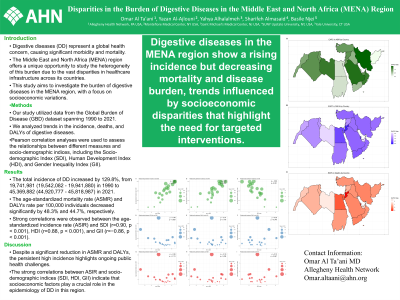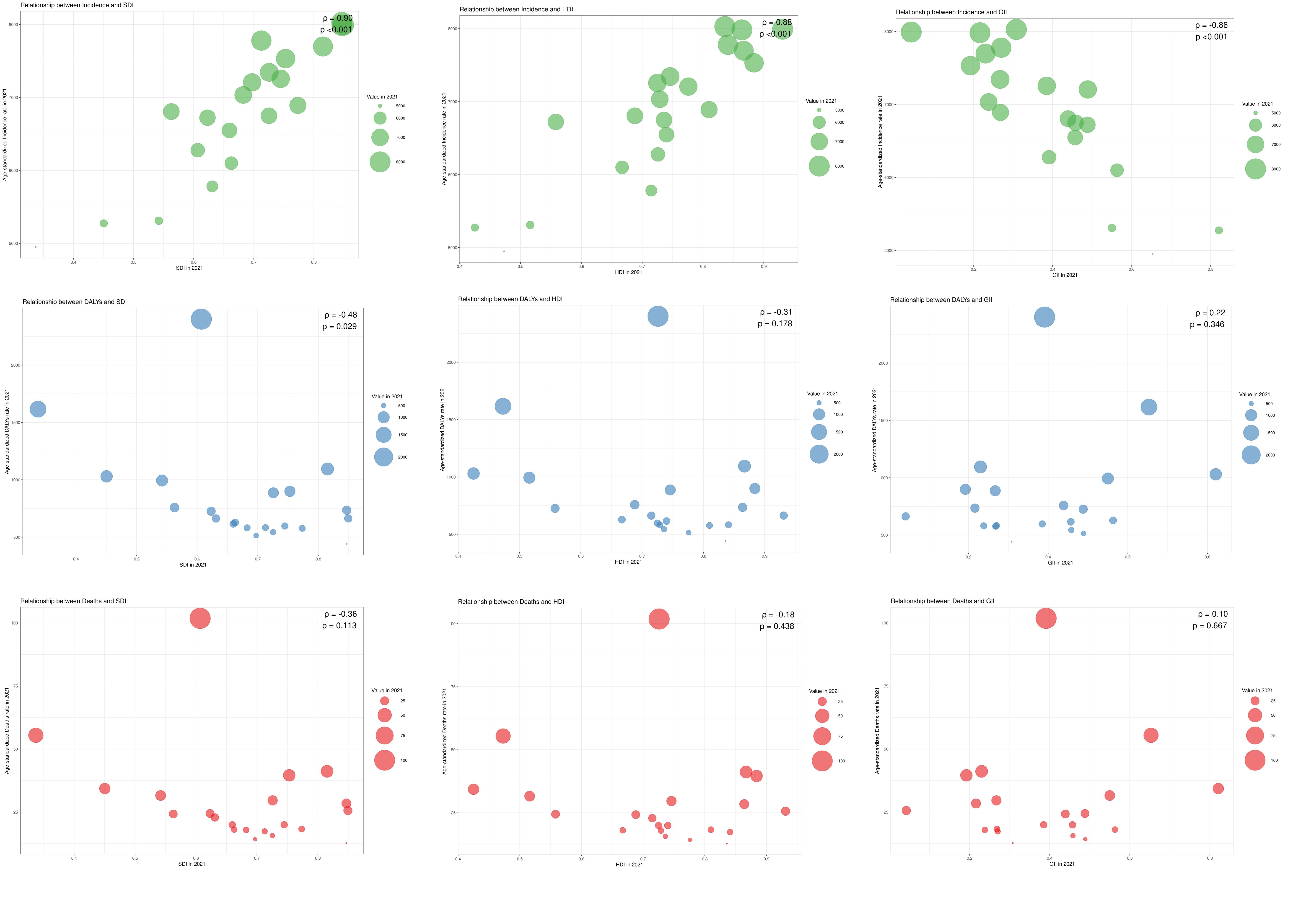Tuesday Poster Session
Category: Practice Management
P4908 - Disparities in the Burden of Digestive Diseases in the Middle East and North Africa (MENA) Region
Tuesday, October 29, 2024
10:30 AM - 4:00 PM ET
Location: Exhibit Hall E

Has Audio
- OA
Omar Al Ta'ani, MD
Allegheny Health Network
Pittsburgh, PA
Presenting Author(s)
Omar Al Ta'ani, MD1, Yazan Al-Ajlouni, MD2, Yahya Alhalalmeh, MD3, Sharifeh Almasaid, MD4, Basile Njei, MD5
1Allegheny Health Network, Pittsburgh, PA; 2Staten Island University Hospital, Northwell Health, New York, NY; 3New York Medical College - Saint Michael's Medical Center, Newark, NJ; 4SUNY Upstate Medical University, Johnson City, TN; 5Yale University School of Medicine, New Haven, CT
Introduction: Digestive diseases (DD) are a significant global health concern, contributing to considerable morbidity, mortality, and economic burden. The Middle East and North Africa (MENA) region presents a unique location to explore the heterogeneity of this burden due to its diverse socioeconomic development and healthcare infrastructure. This study investigates the burden of digestive diseases in the MENA region, focusing on the impact of socioeconomic variations on disease incidence and outcomes.
Methods: We utilized data from the Global Burden of Disease (GBD) dataset covering the period from 1990 to 2021. We analyzed trends in incidence, deaths, and Disability-Adjusted Life Years (DALYs) for digestive diseases, calculating percentage changes and estimated annual percentage changes (EAPCs) in age-standardized rates. Linear regression was used to compute EAPCs, while Pearson correlation analyses assessed relationships between these measures and socio-demographic indices, including the Socio-demographic Index (SDI), Human Development Index (HDI), and Gender Inequality Index (GII).
Results: The total incidence of DD increased by 129.8%, from 19,741,981 cases in 1990 to 45,369,882 cases in 2021. However, the age-standardized mortality rate and DALYs rate per 100,000 individuals decreased significantly by 48.3% from 66.69 to 34.49 and 44.7% from 1,823.76 to 1,009.32, respectively. Strong correlations were observed between the age-standardized incidence rate and SDI (r=0.90, p < 0.001), HDI (r=0.88, p < 0.001), and GII (r=−0.86, p < 0.001). The EAPCs for incidence, deaths, and DALYs were 0.79 (95% CI: 0.74 - 0.84), -2.29 (95% CI: -2.32 - -2.25), and -1.88 (95% CI: -1.93 - -1.82), respectively.
Discussion: Our findings highlight the substantial and increasing burden of DD in the MENA region, with incidence rates rising significantly over the past three decades. Despite reductions in age-standardized mortality rate and DALYs, the persistently high incidence rates reflects ongoing public health challenges. The strong correlations between ASIR and socio-demographic indices (SDI, HDI, GII) suggest that socioeconomic factors critically influence the epidemiology of DD in this region. Our results show the need for targeted public health interventions and policies to address these disparities, aiming to alleviate the impact of DD and improve health outcomes across the MENA region.

Disclosures:
Omar Al Ta'ani, MD1, Yazan Al-Ajlouni, MD2, Yahya Alhalalmeh, MD3, Sharifeh Almasaid, MD4, Basile Njei, MD5. P4908 - Disparities in the Burden of Digestive Diseases in the Middle East and North Africa (MENA) Region, ACG 2024 Annual Scientific Meeting Abstracts. Philadelphia, PA: American College of Gastroenterology.
1Allegheny Health Network, Pittsburgh, PA; 2Staten Island University Hospital, Northwell Health, New York, NY; 3New York Medical College - Saint Michael's Medical Center, Newark, NJ; 4SUNY Upstate Medical University, Johnson City, TN; 5Yale University School of Medicine, New Haven, CT
Introduction: Digestive diseases (DD) are a significant global health concern, contributing to considerable morbidity, mortality, and economic burden. The Middle East and North Africa (MENA) region presents a unique location to explore the heterogeneity of this burden due to its diverse socioeconomic development and healthcare infrastructure. This study investigates the burden of digestive diseases in the MENA region, focusing on the impact of socioeconomic variations on disease incidence and outcomes.
Methods: We utilized data from the Global Burden of Disease (GBD) dataset covering the period from 1990 to 2021. We analyzed trends in incidence, deaths, and Disability-Adjusted Life Years (DALYs) for digestive diseases, calculating percentage changes and estimated annual percentage changes (EAPCs) in age-standardized rates. Linear regression was used to compute EAPCs, while Pearson correlation analyses assessed relationships between these measures and socio-demographic indices, including the Socio-demographic Index (SDI), Human Development Index (HDI), and Gender Inequality Index (GII).
Results: The total incidence of DD increased by 129.8%, from 19,741,981 cases in 1990 to 45,369,882 cases in 2021. However, the age-standardized mortality rate and DALYs rate per 100,000 individuals decreased significantly by 48.3% from 66.69 to 34.49 and 44.7% from 1,823.76 to 1,009.32, respectively. Strong correlations were observed between the age-standardized incidence rate and SDI (r=0.90, p < 0.001), HDI (r=0.88, p < 0.001), and GII (r=−0.86, p < 0.001). The EAPCs for incidence, deaths, and DALYs were 0.79 (95% CI: 0.74 - 0.84), -2.29 (95% CI: -2.32 - -2.25), and -1.88 (95% CI: -1.93 - -1.82), respectively.
Discussion: Our findings highlight the substantial and increasing burden of DD in the MENA region, with incidence rates rising significantly over the past three decades. Despite reductions in age-standardized mortality rate and DALYs, the persistently high incidence rates reflects ongoing public health challenges. The strong correlations between ASIR and socio-demographic indices (SDI, HDI, GII) suggest that socioeconomic factors critically influence the epidemiology of DD in this region. Our results show the need for targeted public health interventions and policies to address these disparities, aiming to alleviate the impact of DD and improve health outcomes across the MENA region.

Figure: The relationship between different sociodemographic indices with the incidence, deaths, and DALYs of digestive diseases in the MENA region.
Disclosures:
Omar Al Ta'ani indicated no relevant financial relationships.
Yazan Al-Ajlouni indicated no relevant financial relationships.
Yahya Alhalalmeh indicated no relevant financial relationships.
Sharifeh Almasaid indicated no relevant financial relationships.
Basile Njei indicated no relevant financial relationships.
Omar Al Ta'ani, MD1, Yazan Al-Ajlouni, MD2, Yahya Alhalalmeh, MD3, Sharifeh Almasaid, MD4, Basile Njei, MD5. P4908 - Disparities in the Burden of Digestive Diseases in the Middle East and North Africa (MENA) Region, ACG 2024 Annual Scientific Meeting Abstracts. Philadelphia, PA: American College of Gastroenterology.
